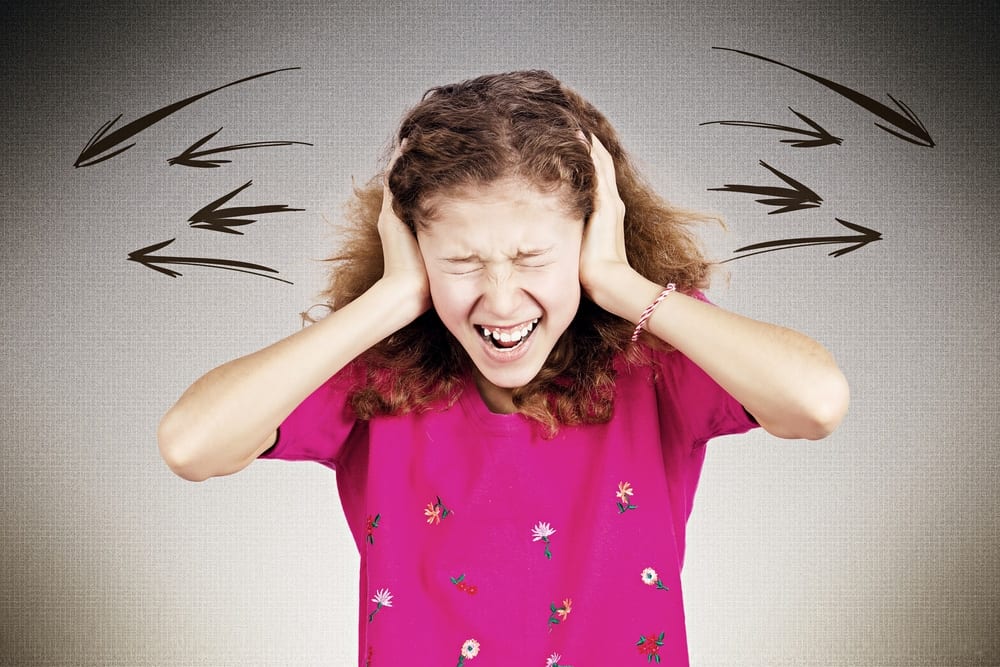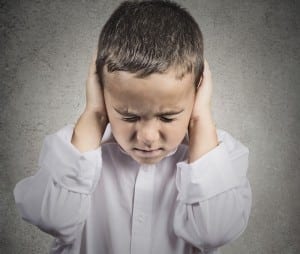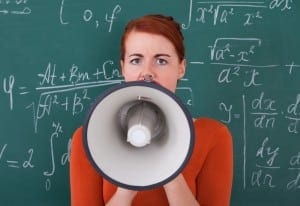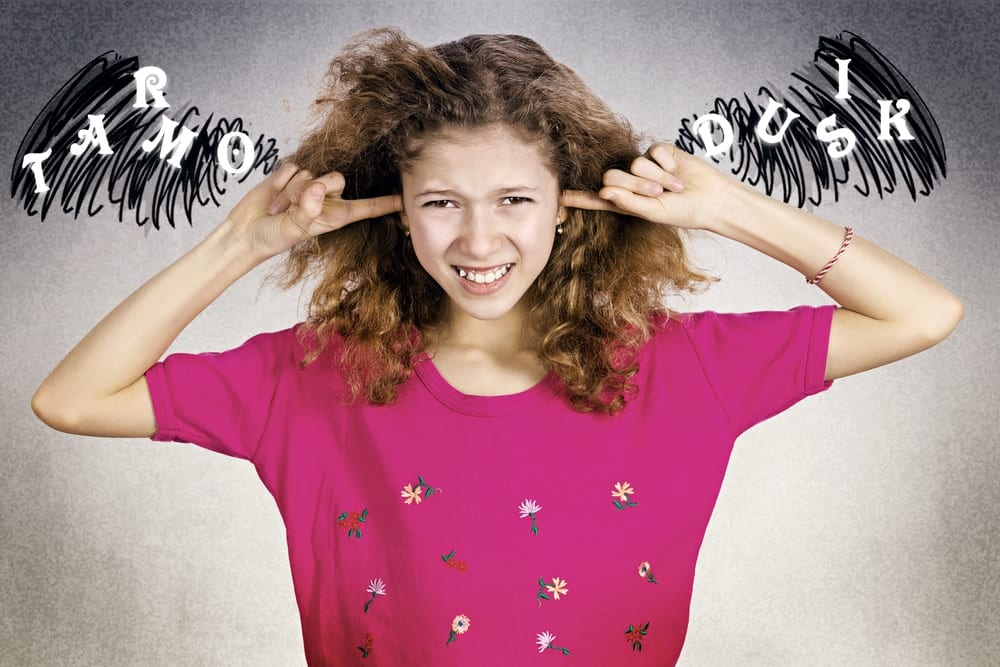Auditory Processing Disorder: it’s what the experts call it when your child’s hearing is just fine, but she doesn’t always understand what is said. Does your child say, “What?” no matter how loud or slow you say things? Is she agitated in noisy public spaces? Does she greet most questions with a blank stare? She may have an auditory processing disorder. An estimated one in twenty children has it and it’s on the rise.
Auditory processing is a series of complex operations performed by the central nervous system that cause no difficulty for most children. They hear sounds and understand them just fine. But for some children, the sounds they hear might as well be in a foreign language, though the child’s ears are working fine. In auditory processing disorders, the brain cannot interpret the information that the ears hear.
One child may not understand what she hears where there is lots of background noise. She can’t seem to filter the sounds she needs to hear from the sound of the crowd in the surrounding environment. Another child has trouble following instructions. A third child has an excellent head for math and no hearing problems at all, but when confronted with word problems, is completely lost. All of these situations may signify an auditory processing disorder.
But that’s only the beginning of the issues a parent might see in a child with one of the many issues that fall under the heading of auditory processing disorder (APD) or central auditory processing disorder (CAPD), as it is sometimes known to show its origins as a disorder of the central nervous system. There are myriad ways in which APD is expressed.
There is the child with APD who is upset by loud or sudden noises. She bursts into tears when an airplane flies overhead, or puts her hands over her ears when you take her clothes shopping at a busy mall. It is obvious to you as a parent, that your child is overly sensitive to auditory information.
Sometimes the problem with processing auditory information is due to a learning difficulty. The child diagnosed with attention deficit/hyperactivity disorder (ADHD), for instance, generally needs more time to process auditory information. That may mean that by the time you’re finished saying, “Can you go to the store and buy a dozen eggs?” she has grasped that you want her to go to the store, but has missed the end of your sentence completely. Her brain needed more time to process the words she hears—more time that is, than the time it took you to say them.
She might answer, “What?” infuriatingly, every time you ask her to do something. It’s not just a stalling technique to gain time: in her effort to puzzle out what you’ve said at the beginning, she’s lost the end.
In fact, there may be more than one difficulty getting in the way of your child’s ability to process what she hears. You may have noticed your child has no trouble understanding the spoken word in a one-on-one situation, for instance when you read her a bedtime story, but she is hopelessly lost in the classroom where the slightest sound distracts her: a child’s foot swinging endlessly behind her, the sound of chalk on the blackboard, the clearing of a throat, all seem to conspire against your child’s ability to make sense of the teacher’s voice. She can’t seem to distinguish the background noise from the primary sound she’s meant to hear. It all sounds somehow the same.
 Here there may be a dual problem of distraction as well as a difficulty in filtering sounds. For such a child, a freer classroom environment is pure torture. The teacher may not mind noise in the classroom, but the child with APD can find it impossible to differentiate the sound of the teacher’s voice from the softer sounds of student chitchat. This is just one possible combination of two entirely different issues that may make it difficult for your child to process auditory information.
Here there may be a dual problem of distraction as well as a difficulty in filtering sounds. For such a child, a freer classroom environment is pure torture. The teacher may not mind noise in the classroom, but the child with APD can find it impossible to differentiate the sound of the teacher’s voice from the softer sounds of student chitchat. This is just one possible combination of two entirely different issues that may make it difficult for your child to process auditory information.
The variables of auditory processing disorders can be seen in the example of the baby who is learning the concept of heat by way of the word “Hot.” As the baby reaches out for a piece of hot potato, her mother may caution, “Hot!” The baby can feel the heat coming off the steaming piece of food and she can hear the urgency and caution in her mother’s voice. She stops reaching for the food and notices that in response, her mother’s body relaxes. The baby has correctly used all the signals she receives (touch, sight, sound) to interpret the meaning of the spoken word “Hot!” in this situation.
A baby with APD, on the other hand, may miss or misinterpret some of these crucial signals. For instance, a baby with APD might become alarmed and cry when her mother cautions, “Hot!” Or she may be distracted by the radio playing a hypnotic tune and miss her mother’s cautionary words altogether. Or perhaps her central nervous system can’t register caution in a voice, because to her, caution is a foreign language her brain can’t comprehend.
APD: Five Key Areas
APD can be broken down into five key areas:
- Auditory Figure-Ground Issues: Background noise makes it impossible for the child to pay attention to the lesson at hand.
- Auditory Memory Issues: The child’s memory can’t hold all of the necessary information, such as the items on a list or a set of directions. The memory issue may be immediate, or only cause issues in retrieving the information at a later time.
- Auditory Discrimination Issues: Similar words or sounds may be confused, for instance SHOOT/BOOT or SH/CH. As a result, the child can find it difficult to follow instructions, read, spell, and write.
- Auditory Attention Issues: A short span of auditory attention means a child will miss at least part of most lectures.
- Auditory Cohesion Issues: The child finds it difficult to find the moral in the story, understand a pun, or solve a word problem. These tasks involve high-level listening skills.
APD: General Measures for Parents/Teachers
Here are some general measures that can help children with APD at home and at school.
- Reduce background noise as much as possible at home and at school
- Remind your child to look at the person who is speaking, whether it is you at home, or a teacher in school
- Use simple descriptive sentences (bring the red spoon)
- Speak at a slower pace and at a slightly increased volume
- Have your child repeat your instructions once or if helpful, until the task is complete
- Offer written instructions
- Have your child wear a watch
- Develop and stick to an organized household or classroom routine
- Teach your child to be aware of background noise and to move to a quieter place when necessary
- Provide a quiet study space for your child
- Ask the teacher to seat your child at the front of the room, and if possible, with the child’s back to the window
It’s important to understand that APD is real and it’s stressful for your child. Bolster self-confidence by offering realistic praise for her achievements. Children with APD can and do go on to become productive adults. Like any other obstacle, living successfully with APD is about finding and using effective coping techniques to get on with living life to the fullest.
The good news is that APD is treatable and is not a global higher-order disability along the lines of autism or intellectual disabilities. Treatment falls into three main areas: changing the learning environment, teaching the child compensation measures, and remediating the root cause of the auditory deficit. If you suspect your child may have an auditory processing disorder you will want to have her evaluated by an audiologist.

Thanks for this post, I have a daughter that fits this description exactly. If anyone has any resources that provide long term solution, please share with me.